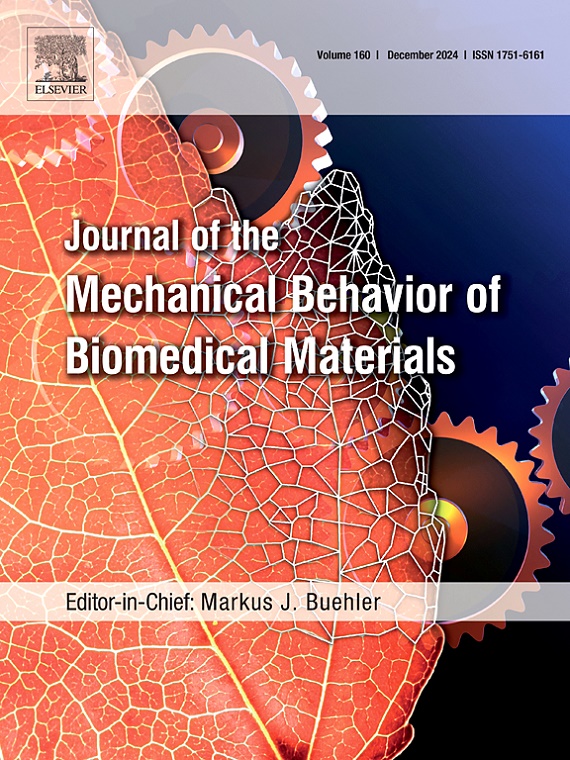开发基于骨重塑模型和疲劳失效的多孔髋关节植入物,实施拓扑优化。
IF 3.3
2区 医学
Q2 ENGINEERING, BIOMEDICAL
Journal of the Mechanical Behavior of Biomedical Materials
Pub Date : 2024-12-09
DOI:10.1016/j.jmbbm.2024.106864
引用次数: 0
摘要
在当代骨科实践中,全髋关节置换术(THA)是一种可靠的髋关节置换术。然而,将固体植入物引入人体骨组织会导致并发症,特别是应力屏蔽和皮质肥大。这些问题通常源于实体植入物与骨组织之间的机械不匹配,特别是刚度差异。一种潜在的解决方案是采用具有较低刚度和可调谐力学性能的多孔植入结构,该结构基于孔隙度、相对密度和单元胞尺寸等形态学参数。本研究旨在开发满足生物学和制造要求的多孔种植体,采用拓扑优化方法解决传统固体种植体的相关挑战,对骨科种植体的发展具有重要意义。为了实现这一目标,我们进行了有限元分析,比较了健康骨骼与固体和新开发的多孔植入物在真实载荷条件下的应力分布。多孔植入物设计具有三周期最小表面结构,具有均匀的相对密度和梯度相对密度映射,考虑了增材制造能力和生物约束。我们的研究结果为种植体的选择对骨力学环境的影响提供了重要的见解。具体来说,实体种植体显著降低皮质骨内的外加应力,导致应力屏蔽和随后的骨吸收,符合骨重塑原理和Wolff定律。然而,替换具有最大柔度的均匀孔隙度的固体种植体,采用基于拓扑优化方法的梯度多孔种植体可显著提高应变能密度比。其中,均匀旋转杆、均匀金刚石杆、梯度旋转杆和梯度金刚石杆的应力屏蔽效应分别比固体杆提高43%、39%、27%和25%,有效缓解了应力屏蔽效应。然而,在多孔茎中,只有梯度设计才能满足机械强度要求,且安全系数大于1,使其适合替代旨在解决相关并发症的固体植入物。这些结果带来了希望,特别是随着增材制造方法的进步,能够以可接受的精度制造这些多孔植入物。本文章由计算机程序翻译,如有差异,请以英文原文为准。

Developing porous hip implants implementing topology optimization based on the bone remodelling model and fatigue failure
In contemporary orthopaedic practice, total hip arthroplasty (THA) is a reliable surgical technique for hip joint replacement. However, introducing solid implants into human bone tissue can lead to complications, notably stress shielding and cortical hypertrophy. These issues often stem from mechanical mismatches, particularly stiffness disparities, between the solid implants and the bone tissue. A potential solution lies in adopting porous implant structures with lower stiffness and tuneable mechanical properties based on morphological parameters such as porosity, relative density, and unit cell sizes. This study, which is of significant importance to orthopaedic implant development, aims to develop porous implants that meet biological and manufacturing requirements, employing topology optimization methods to address the challenges associated with conventional solid implants. To achieve this objective, we conducted finite element analyses to compare the stress distribution within healthy bones with solid and newly developed porous implants under real-life loading conditions. The porous implants were designed with triply periodic minimal surface structures, featuring uniform relative density and gradient relative density mapping derived from topology optimization results considering additive manufacturing capabilities and biological constraints. Our findings provide critical insights into the impact on the bone's mechanical environment about the choice of implant. Specifically, solid implants significantly decrease applied stress within the cortical bone, leading to stress shielding and subsequent bone resorption, consistent with bone remodelling principles and Wolff's law. However, replacing the solid implant with uniform porosity with maximum compliance and employing gradient porous implants based on topology optimization methods significantly increases the strain energy density ratio. Specifically, the uniform gyroid, uniform diamond, gradient gyroid, and gradient diamond stems exhibited increases of 43%, 39%, 27%, and 25%, respectively, compared to the solid stem, effectively mitigating the stress shielding effect. However, amongst porous stems, only gradient designs could meet the mechanical strength requirements with a safety factor greater than one, rendering them suitable replacements for solid implants aimed at addressing associated complications. These results hold promise, particularly with the advancements in additive manufacturing methods capable of fabricating these porous implants with acceptable precision.
求助全文
通过发布文献求助,成功后即可免费获取论文全文。
去求助
来源期刊

Journal of the Mechanical Behavior of Biomedical Materials
工程技术-材料科学:生物材料
CiteScore
7.20
自引率
7.70%
发文量
505
审稿时长
46 days
期刊介绍:
The Journal of the Mechanical Behavior of Biomedical Materials is concerned with the mechanical deformation, damage and failure under applied forces, of biological material (at the tissue, cellular and molecular levels) and of biomaterials, i.e. those materials which are designed to mimic or replace biological materials.
The primary focus of the journal is the synthesis of materials science, biology, and medical and dental science. Reports of fundamental scientific investigations are welcome, as are articles concerned with the practical application of materials in medical devices. Both experimental and theoretical work is of interest; theoretical papers will normally include comparison of predictions with experimental data, though we recognize that this may not always be appropriate. The journal also publishes technical notes concerned with emerging experimental or theoretical techniques, letters to the editor and, by invitation, review articles and papers describing existing techniques for the benefit of an interdisciplinary readership.
 求助内容:
求助内容: 应助结果提醒方式:
应助结果提醒方式:


